The type of flowering hydrangea always creates a feeling of indescribable lightness and airiness. Lush neat inflorescences will become a spectacular decoration for any garden or flower bed. There are more than 35 types of hydrangea, but in this article we will talk only about the most popular and suitable for growing in the garden. Here you will learn everything about landing and caring for hydrangeas in the open soil.
Morphological features of hydrangea
Hydrangea accounted for many gardeners. This is a high magnificent flowering plant, most of whose species are capable of wintering in the open ground. Inflorescences please the eyes from mid-summer until the beginning of October. Hydrangea refer to the family of hydrangea, in which there are not only shrubs, but even many species of lian and low-spirited trees.
I wonder: Hortensia has gained its name in honor of the ancient Roman princess. She also has a Latin name Hydrangea, which has already been awarded scientists for excessive love for high humidity (literal translation - "water tank"). The Japanese has its own name - "adsisay", which is translated as "flower - purple sun."
Only a few grades of hydrangea are adapted for growing at home, the rest do not differ compactness and can only live in the open soil. In nature, shrubs can reach 3 m in height, some kind of evergreens, others - deciduous. In the middle strip there are predominantly leaf falling hydrangeas. Sheets of it mainly large oval shapes with a pointed top, pronounced by the housing and jealous edges. Blossom starts from the middle of spring and continues until the beginning of the autumn. Inflorescences have a spherical, tweeted or football form and consist of two types of flowers: fluttering small, which are located closer to the center of inflorescences, and fruitless large (decorative), dispersed around the edges. But there are species that all the flowers are small and fluttering (differ in small decorativeness). It is noteworthy that most types of hydrangea bloom in white, but some, for example, large hydrangea, give cream, red, lilac and pink colors. At the same time, the color depends not on the characteristics of the variety, but on the chemical composition of the soil. On landing large hydrangea and controlling its colors, we will tell a little later. Fruit of hydrangea 2-5 chamber boxes with seeds.
Types of hydrangea
Before you begin to plant the hydrangea in the garden, it would be nice to choose a suitable shrub variety. Each of the types requires its agrotechnical conditions, so when choosing, repel from your own experience and opportunities to provide those.
Types of hydrangea:
- The tree is the most popular appearance that can be found in almost every garden. This is a tall shrub tall from 1 to 3 m with inflorescences formed at the ends of one-year shoots. When flowers only bloom, they are painted in a greenish tint, but over time they change the color on white or cream. The most common varieties include "Annabel", "Grandiflora", "Invizable Spirit".

- Miscellaneous - In the wilderness, this species is found in the form of a bush or a lowered tree from 2 to 5 m. Planting a gardening garbage hydrangea is very popular because it provides an annual decoration for 40 years or more. Fast rustling shoots are resistant to frost. As in the case of tree hydrangea, inflorescences appear on the vertices of annual shoots, and therefore the flowering is distinguished by an extraordinary magnitude, but it comes off already in mid-August or early September. The inflorescences first are greenish, as the flowers dissolve the flowers become pink, then bricks and at the end of the cycle again acquire a greenish tint. Among the most interesting varieties can be allocated "Tardiva", "Vanilla Freiz" and "Kuisha". Another feature of this species can be raised in the form of a neat batch on a small strain. To do this, grow a two-year seedling from the cutter, select the most powerful escape, rest cut. Short it up to the most powerful kidney and continue until it grows up a strab about a meter in height. In the future, pinch the end on the strain to form a crown, and delete all the shoots that will appear on it. Leave only 4-5 strongest for branching. Conduct the removal of weak shoots annually.
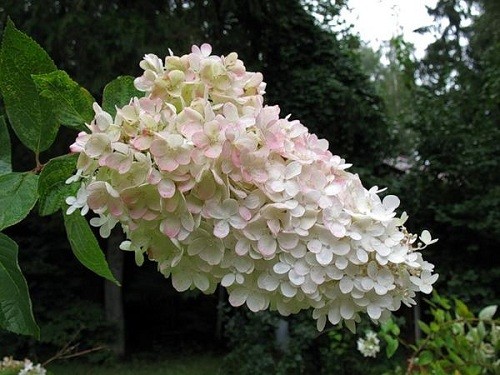
- Large - distinguish several varieties of this hydrangea depending on the size of the bush. Some of them can be grown in an apartment or in containers. The foliage is distinguished by bright green. The shoots are not treated, and therefore they need to be protected from the cold. Nevertheless, the kidneys for shoots are borne by the previous autumn, and therefore it is believed that bloom occurs on last year's shoots. Inflorescences are mainly umbrella form (semi-shaped). The soil acidity is fully affected on coloring. Not so long ago, frost-resistant varieties of large hydrangea were removed: "Endless Summer", "Renata Styinger", "Romance", "Expensn". If you are going to grow conventional heat-loving varieties, in the late autumn, carefully hurt them to the ground and stick with hooks. After that, cover the cheese or foliage to ensure proper thermal insulation.

- Dolisant is one of the most attractive species, but he has one big drawback - it is absolutely not adapted to the cold, and therefore needs careful insulation. Doluctive hydrangea is beautiful, not only lush inflorescences, but also an unusual form of leaves. It can reach up to 2 m in height. Inflorescences from 10 to 30 cm long at the beginning of flowering gently white, and then change the color to purple and completely bloom in the middle of summer.
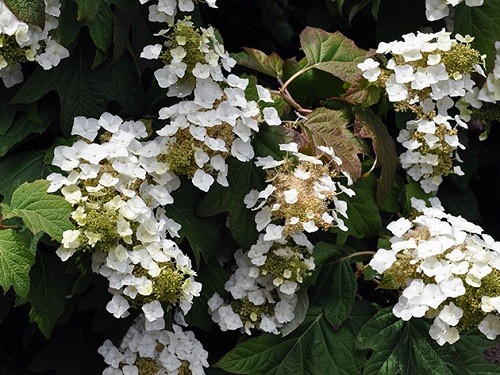
- Sound resistant (durable) - high shrub 2-3 m growth. Differs in frost resistance, so I love gardeners so much. From the soil hydrangea, they often make a straak form. It has long leaves of dark green with a smooth outside and pubescent rear. The inflorescences of shovel and loose, at the beginning of flowering they are white, but as the flowers are dissolved. The peak of flowering falls at the end of June and the beginning of July. The largest popularity of the variety of the Bretenner with large white flowers is used.
In addition to the above species in the gardens, radiant, rough, cherry, ashes, ash and sargen grazent are bred. The latter shoots do not be rushed, so you should not even try to hurt them to the ground - break. To protect the Holtenzia of Sarjent from the cold, wrap the crown with paper or other observer material. Early spring after the end of serious cold weather, remove the shelter and mulch. It is best to choose a cloudy wet evening for this so as not to injure the weak plant with bright sunlight.
Growing hydrangea
Now that you have decided on the type of hydrangea that you can grow, you can talk about the features of landing, care and reproduction. In most cases, hydrangea causes problems, so newcomers and experienced gardeners are equally successfully cope with it.
Landing hydrangea
The landing of the garden hydrangea can be carried out by seed and seedl. In the first case, it is more likely to multiply species varieties of plants and for breeding experiments. The seeds should be dried in the autumn time, burning them into the substrate from the sheet and peat soil with small river sand in the ratio of 4: 2: 1. How to sprinkle the soil from the spray and cover the polyethylene film container to create a greenhouse effect. Periodically, it will need to be removed for ventilation and additional moisturizing - it is impossible to give the soil to push. For the extension of crops, it is necessary to maintain the temperature from + 14C to + 20c. 30-45 days after the appearance of the first shoots, you can remove the film. When seedlings are repaired, seedlings can be divened. Repeated dive is produced in May, while planting each plant in a container with a diameter of 7-8 cm. After that, the young hydrangea should be hardening, exposing the day on fresh air to the shaded place without drafts. At night, seedlings need to be entered into the house.
Hydrangea seedlings can be planted in open ground 2 years after growing at home and regular hardening. Choosing a place for the plant on the site, take into account the fact that most species need good lighting, but there are also those who can feel great and in the shade, for example, Sargen's hydrangea or rough. The soil is best to choose a slightly acidic or neutral, it should be a fertilized organic and have a loose structure so that oxygen can penetrate the roots. To acidify the soil, use a peat or special acider "ESID +". It is necessary to trace so close to the area for hydrangea, culture with a surface root system, like the hydrangea itself. Otherwise, they will constantly fight nutrients and moisture.
For planting hydrangea in the garden, it is necessary to dig a hole, the dimensions that must be halved to exceed the dimensions of the earth coma on a sapling. Add peat, mineral and organic fertilizers to a pit, mix everything with soil. Lower the seedling and pour it off its ground mixed with the compost so that the root comed towards the surface of the Earth. Slightly endure the soil, pour and quay a cheese to protect the roots during the adaptation period from overheating, as well as reduce the development of weeds. Around the plant, crumble the organic mulch with a layer to 10 cm. Subsequently, it will decompose and oxidizing the soil, which will be very useful for hydrangea. Experts recommend to make a mulch at the end of spring, as the land is still quite humid, but at the same time managed to warm up. In the fall, the mulch is brought after stably cold weather.
In order for hydrangea to grow rapidly and fluffle, it is necessary to make fertilizers from time to time. You can find special compositions enriched with iron and magnesium. They are added immediately before landing and during intensive development. The first feeding comes from the end of May or the beginning of June and is a liquid overwhelming chicken litter, diluted with water 1:10. It may also be mineral fertilizer from superphosphate, urea and potash nitrate in a 2: 1: 1 ratio. Further feeders should be held every 2-3 weeks. Fertilizers cease to make in late July so that the plant "calmed down" and was preparing for wintering. If this is not done, the shoots will not have time to ober.
Care for hydrangea
It is easy to care for garden hydrangea, but there are mandatory moments that require strict performance. The most important condition for the care of the plant is thorough and correct watering - water should be warm and rescued. Each adult hydrangea requires about 40 liters of water twice a week in the hot period and once a week - in more moderate. If there is a peat mulch in the soil, you can watered a little less often, since this material perfectly holds moisture.
To improve the aeration of the roots, it is recommended to periodically loosen the land around the plant at a depth of no more than 5 cm. Switchless shoots should be trimmed. As for diseases and pests, the hydrangea rarely becomes their victim. On the leaves, you can sometimes notice a spider tick, from which you can easily get rid of soapy solution. When growing in pallets or pots, a sheet wave may be laid. If the year was wet, mildewing dew may appear on young shoots and foliage. If you have noticed that the leaves became lighter, it may indicate chlorose, the cause of which is an excess of lime or humus.
Highlights of carbon monoxide:
- the plant loves moisture very much, but not only the amount of water, but also its quality (warm and distinguished);
- for lush and colorful flowering of hydrangea, you need a lot of sunlight, but the leaves will burn under the right rays, therefore it is best to plant it in place, where from 12:00 to 15:00 there will be a weak half-day;
- in second place in importance after irrigation, there is a regular and proper trimming, which we will tell a little later;
- it is not necessary to overflow a hydrangea with organic fertilizers, otherwise it will only grow up to grow old, but it will not give lush colors (all energy will go into growth);
- even if you planted a frost-resistant look, it does not mean that it does not need to be covered by winter. If the plant has frozen, give it time - it is quite possible that it will independently restore in the growing period;
- if you bought and planted the blooming hydrangea, observe the proportions of the underground and ground parts - the root system and pit, dumped for it, should not be less than the ground part of the plant. If the roots are much inferior in size in the size of the terrestrial flowering part of the hydrangea, this suggests that the plant was kept on drip watering and fertilizers to impart a proper species. When planting such a plant in an open ground, you should not rinse the earthen com and release the roots as it is often advised on the Internet. So you just hurt the root system and weaken it;
- if you planted the blooming bush of hydrangea, but after a couple of weeks it began to wake, then the plant cannot adapt to new conditions. In the nursery, most likely, he was kept on powerful fertilizers, and he did not have to apply effort so that with the help of the root system to produce nutrients from soil and water. It is necessary to gradually train the roots of such hydrangea, having learned from potent fertilizers. The first couple of months after landing once in 10-14 days, make fertilizers.
Fertilizer for hydrangea
In order for the color hydrangea as much as possible, at least twice a year to carry out a comprehensive feeder. The first is carried out before flowering, the second - after. In April, it is necessary to pour hydrangea with a solution of 20 g of urea, divorced in a bucket of water. One adult plant will need 3 buckets of such fertilizer. When hydrangea is swinging, it needs to be filled with mineral fertilizers. During the season, it is possible to occasionally make a dung alive, but not too much (which happens during an excess of organic fertilizers, you already know).
About planting hydrangea of \u200b\u200btree-like, large-scale or soil solid can be changed in coloration of inflorescences, varying the acidity of the soil. If desired, white and cream flowers can become blue, blue and even violet. Pinkish and raspberry flowers are obtained from a weak alkaline reaction, they purchase blue color on sour soil. Cream and pink flowers faster change the shade, which you can't say about pure white whose color is very difficult to change.
If you create an alkaline environment, the hydrangea will be unable to take iron from the soil, namely, this element affects color color. Iron can be absorbed exclusively in an acidic environment. If alkaline soil in the garden, and you want to get a blue color, water the plant with a solution of iron salts. To strengthen blue, instill under each bush metal chips or unnecessary small metal objects, such as nails or scrap. It may happen so that multicolored inflorescences will dissolve on one bush. Also, blue can manifest itself in bushes landed in peat ground, but there is a high probability that the color will be "dirty".
You can cut only those bushes that have achieved 3-4 years. Types blooming on shoots of this year should be trimmed at the beginning of the spring until the time when the juice moves, and the kidneys will dissolve. Otherwise, the plant may well die from expire for juices through cuts. However, it is not too early to cut it - it turns out a cuttings that are unsuitable for rooting. The perfect time for trimming occurs when the kidneys swell a little and begin to "revive." The very first should be trimmed with a tree hydrangea, because it "wakes up" before others. Cut off its shoots at an altitude of 3-4 kidneys, and divide the cuts on the cuttings. We should be a little more careful with the Battle of Hydrangea, cutting the shoots of last year by one third. The largest view is almost not cut off, only a little rejuvenate with the removal of each 4 escape, especially if it is directed inside the bush.
Gorutniewicz breeding
As it was already possible to guess, the hydrangea is breeding with stalling, dividing bush, seeds or vaccination. We have already spoken about the seed method. The optimal time for the squeezed landing of hydrangea is the middle of July, when flowering peak comes. Cut the cuttings from not too large annual side shoots, which are quite enough on any bush. Soothes should be young and do not break when flexing. Those that older and have already managed to be worn, rooted much worse. The hauling can be carried out before the flowering start, but then when cutting the cuttings, at the base, it is necessary to maintain a small part of last year's escape, cutting off the stalk "with a heel".
To roam the cuttings, prepare a lightweight substrate from a peat mixture with a large sand in a 2: 1 proportion. Peat gives a weak sour reaction, which speeds up the growth of the root system. To increase the moisture intensity, it is recommended to add moss-sfagnum into the soil chopped by small pieces. Treat the cuttings "root" and deepen into the soil for 2-3 cm, withstanding a distance of 5 cm from each other. Full rooting should occur after 20-27 days, and during this time should be maintained from + 16C to + 20 ° C. Plants must be in light shading. Modifying the hydrangea division of the bush is very simple. To do this, it is necessary to dig a bush early in spring to a slotting or in the fall after flowering, divide it into 2-3 parts so that each of them was at least 3 kidneys.
On the video of landing of hydrangea, all the subtleties of the process are shown in detail:
Zimovka Hortensia
After the end of the flowering period, you can begin to prepare hydrangea to wintering. Young seedlings that grow in boxes and pots, you need to move into a house or barn, and the garden plants have dried inflorescences. If this is not done and leave inflorescences for the winter, it may be snowing on them and ice to form, which will lead to the rustling of shoots. In addition to trimming, it is necessary to highly glue the bushes at the bases and climb the earth around them so that the root system does not penetrate. The most frost-resistant are the soil and sweatshirt species. Their young shoots are quickly covered by the bark, so they can carry relatively warm winter even without cover. A tree hydrangea and can survive a harsh winter without insulation, but still it is better not to risk and guard the plants, because no one is able to predict, to which mark the thermometer is dropped.
Stripping the hortensia for the winter is better with the onset of the first night freezers, which usually appear in October. Young bushes can be simply filled with a dust soil. The older plants need to be carefully hooked up to the ground and pinch, and then cover the rubberoid or Loutrasil and press the material with bricks. With adult bushes, you will have to face longer: the shoots should be neatly tied and wrapped with underpox material (Loutrasil, spunbond). After that, around each bush, a rounded frame of steel mesh should be built so that its inner walls are at a distance of at least 20 cm from the bush. The upper face of the grid should be higher than the bush by 10-15 cm. The remaining internal space fill the fill or cheese. With the onset of spring, the grid can be dismantled, and when the freezing will finally stop, it is possible to remove and passionate material.
Planting hydrangea: photo
Landing the hydrangea in the spring will give you a magnificent decoration for the garden, and finally offer to see a small photo generation of the most original varieties and colors:

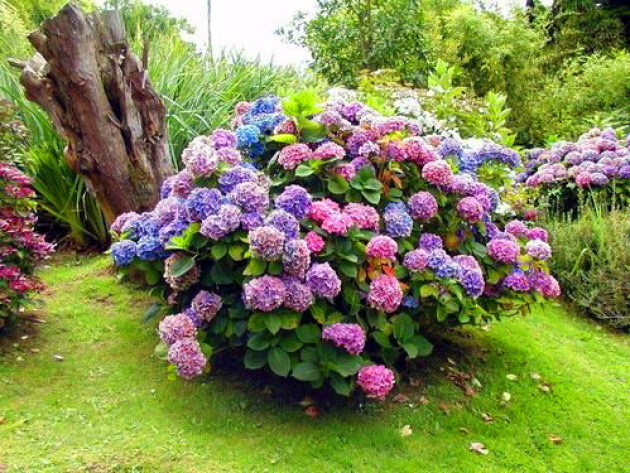
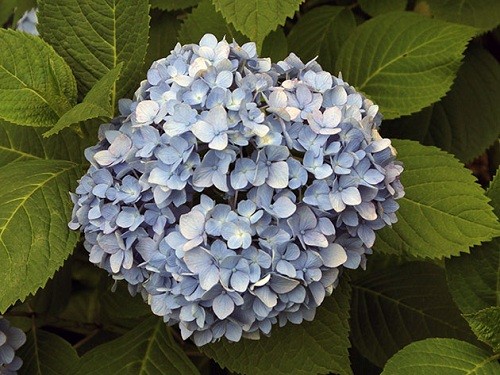
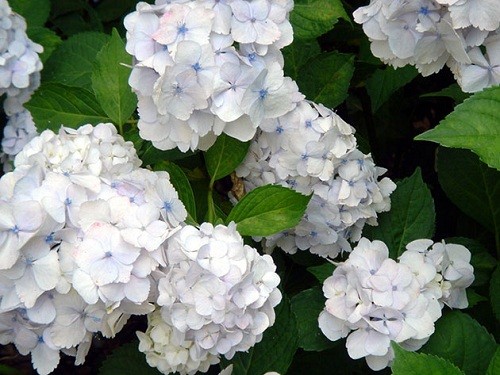
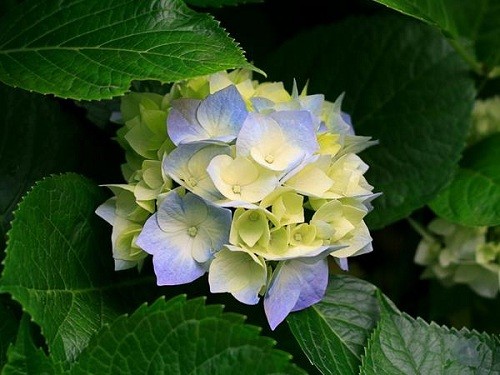
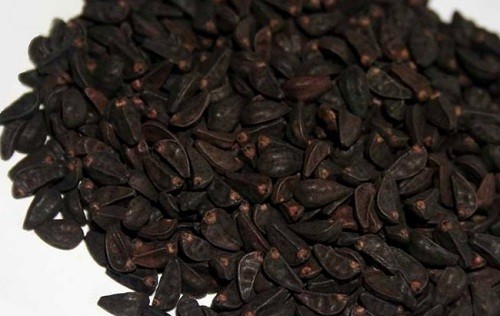
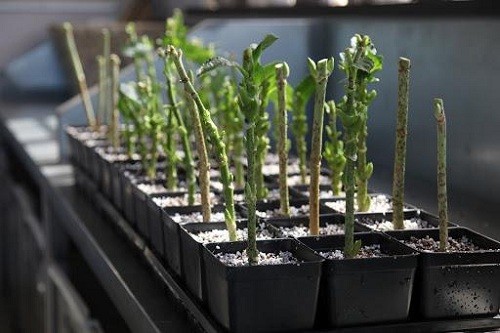
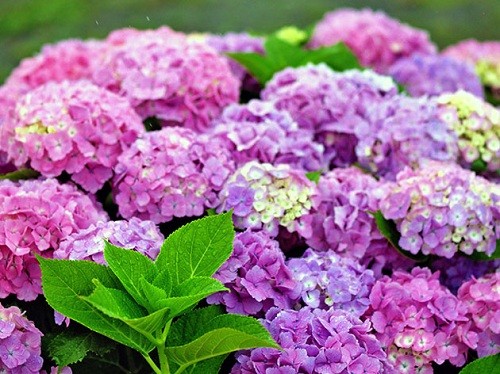
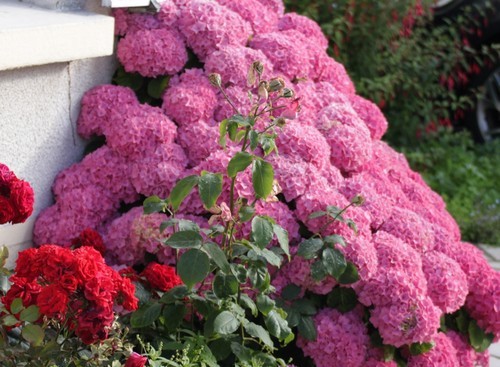
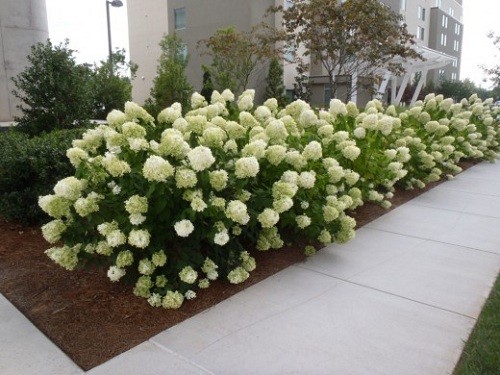
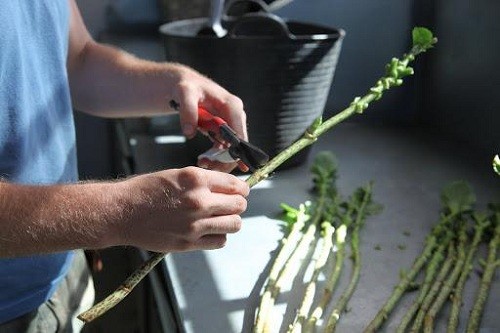
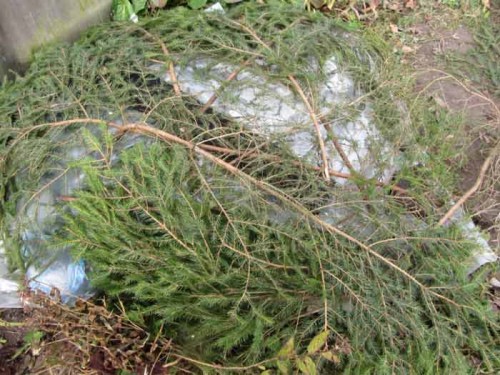
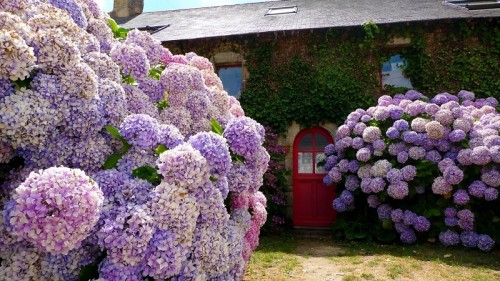
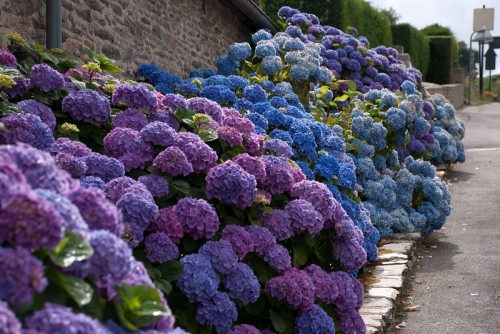
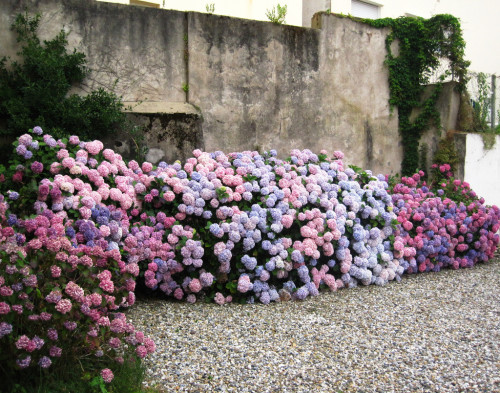
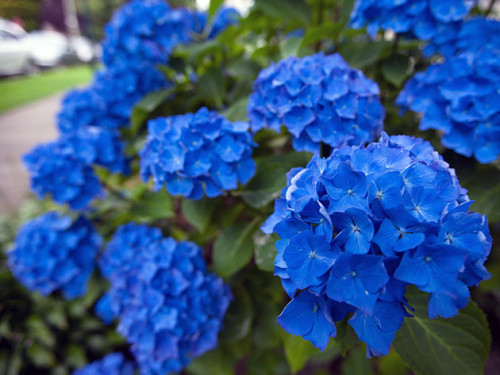
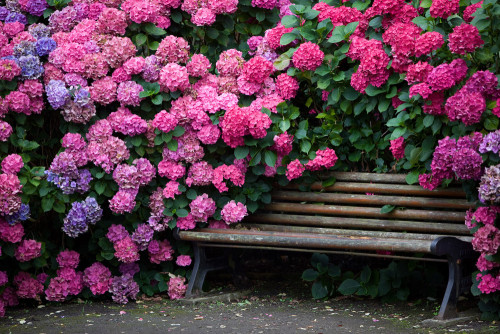












 Start a discussion ...
Start a discussion ...